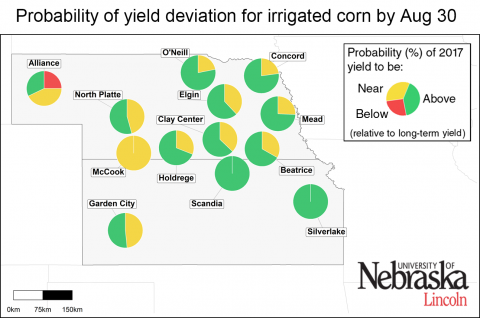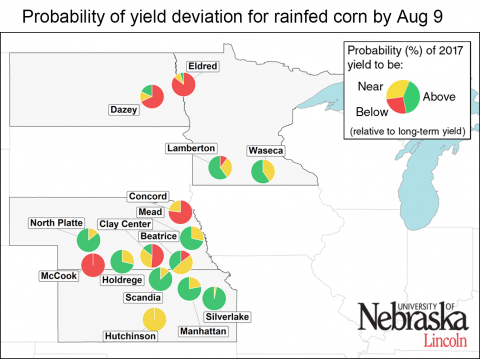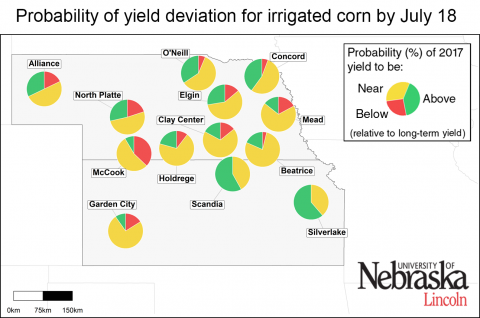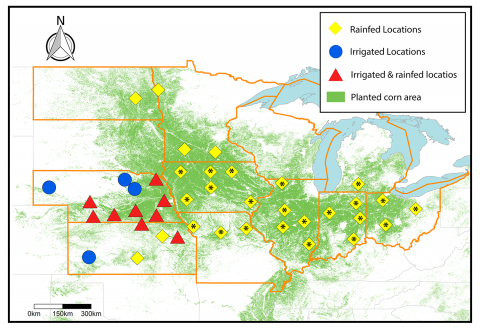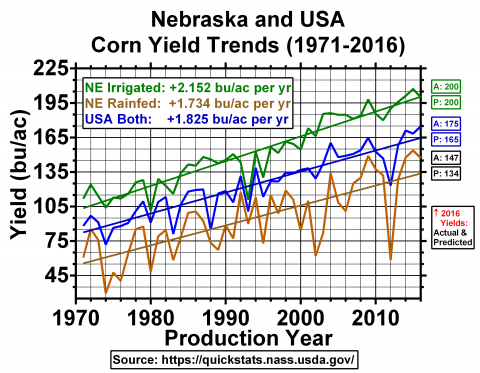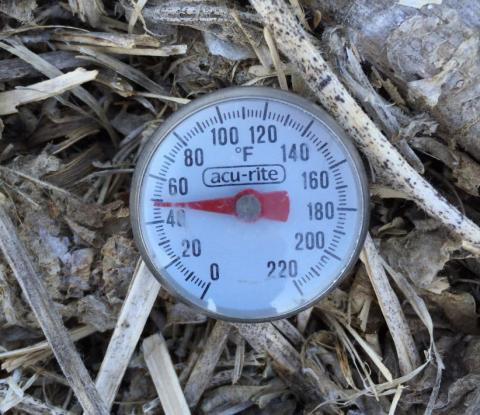2017 Corn Yield Forecasts as of September 20
September 21, 2017
Crop modelers wrap up their forecasts of rainfed and irrigated corn yields across the Corn Belt for 2017, noting above-average yields for about 80% of the irrigated sites and more than 60% of the rainfed sites. Irrigated yields ranged from 11%-17% over long-term averages at those sites and rainfed yields at those sites were 13%-40% above average. View data for all the sites.
2017 Corn Yield Forecasts as of August 30
September 1, 2017
Forecasts for end-of-season corn yields improved across much of the Corn Belt since the early August forecast. View crop stage and yield forecasts as well as weather data. In Nebraska predictions are for near to above average corn yields for most sites, except northeast and northwest sites.
2017 Corn Yield Forecasts as of Aug. 9
August 11, 2017
Corn yield forecasts for Nebraska sites indicate near-average to above average yields for most irrigated sites. There was much more yield variability for rainfed locations where three of the sites were forecast with a 50%-100% chance of below-normal yields and three were forecast for normal yields, while one was near average.
2017 Corn Yield Forecasts as of July 18
July 19, 2017
Corn growth stages are estimated for 41 sites in 10 states and yields are estimated for select irrigated and rainfed sites, based on the Hybrid-Maize model and input from specialists and educators across a 10-state area as of July 18, 2017. The authors note that these early season yield forecasts vary widely, particularly for rainfed fields, and may change considerably by end of season.
2017 Corn Yield Forecasts: Approach and Interpretation of Results
July 6, 2017
This article discusses data and data collection for the Yield Forecasting Center forecasts of crop phenology and yield for 2017, including a map of the site locations and specific data on crop management and soil types for each site.
Soybean and Corn Yield and Acreage Trends through 2016
May 25, 2017
Nebraska soybean and corn yields steadily increased from 1971 to 2016, in both irrigated and rainfed production fields. Charts based on USDA National Agricultural Statistics Service numbers track these changes.
Hindsight of 2016 Corn Yield Forecasts by the Yield Forecasting Center
May 11, 2017
Here we provide an evaluation of the corn yield forecasts released during the 2016 crop season by the Yield Forecast Center. We compared our end-of-season forecasted yield potential against the average corn yields reported by USDA NASS for rainfed and irrigated production.
Corn, Soybean Planting Considerations for this Week’s Cold Snap
April 24, 2017
With nighttime lows predicted to drop several nights this week, growers are advised to cautiously assess the potential for germination problems due to imbibitional chilling before planting. Agronomists advise checking soil temperatures in each field the day of planting as well as forecast temperatures for 24 hours (soybeans) or 48 hours (corn) after planting.


